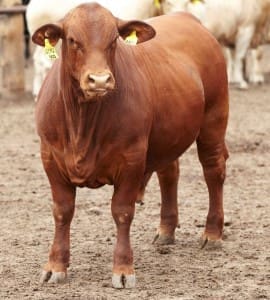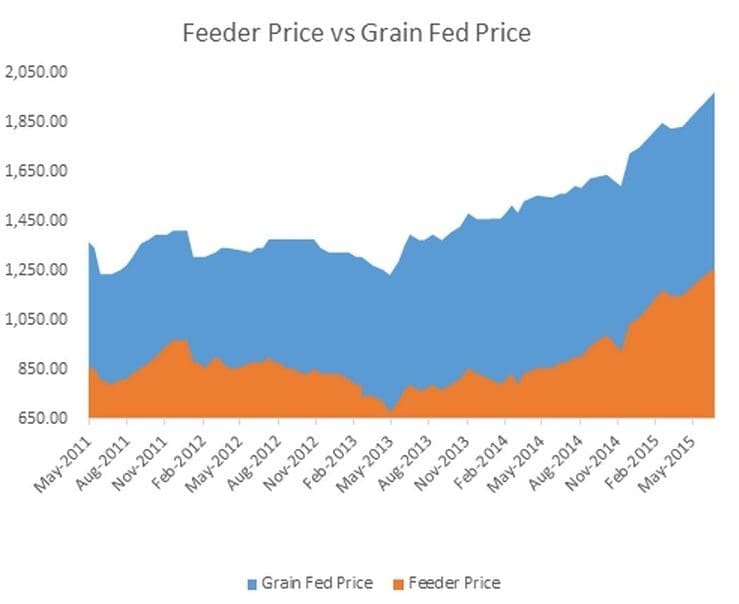SIGNIFICANT red ink has re-emerged in Beef Central’s regular 100-day grainfed trading budget calculated this morning, which has produced a $32 loss on bought steers entering the feedlot today and closing out after 105 days on October 23.
 The result, based on our standard set of variables which can be viewed at the base of this page, is driven by sharp but not unexpected rises in feeder cattle price, plus a solid upwards adjustment in rations.
The result, based on our standard set of variables which can be viewed at the base of this page, is driven by sharp but not unexpected rises in feeder cattle price, plus a solid upwards adjustment in rations.
In combination they have overwhelmed the steady advance seen in grainfed cattle forward price.
Our recent sequence of trading budgets since April have sat close to or just above breakeven, but today represents a new trend line.
For today’s budget, we’ve raised the feeder steer purchase price by 10c/kg to 280c/kg liveweight – equal to our highest-ever feeder purchase price – primarily on the back of the increased demand that’s clearly evident through NSW.
It’s also clearly reflected in saleyards results and the Eastern Young Cattle Indicator which closed at 535c/kg – up close to 200c/kg on this time last year. Over the recent record run of EYCI results, while Queensland is beginning to catch up, the real momentum has come out of southern areas.
Today’s steer value at 280c/kg values him (450kg liveweight) at $1260, again equal to our record-high recorded in this report over the past four years.
As can be seen on our combined graph (feeder price and total production cost) published below, this time a year ago the feeder price was 195c/kg, representing an 85c/kg rise since, worth $382.
At their lowest-ever point in our breakeven reports (May 2013), feeders were worth just $670, representing a rise of $590 since.
It’s hard to see any easing in feeder price ex darling Downs in coming months, and if anything, are only likely to continue to firm, assisted to some extent by recent currency movement and the strength of export markets, along with the obvious tightening of supply.
Feeder bias dissolves
Also worth noting is that the historically unusual bias that’s been evident in heavy feeder pricing over lighter feeders/backgrounders over the past 6-12 months is now showing signs of disappearing.
That’s occurred over the past couple of weeks, as more restocker people have re-entered the market – perhaps showing signs of acceptance that the market is now in a stronger band, but also reflecting strong emerging oats demand for lighter cattle across southern Queensland and NSW. Evidence recent prices at Roma store sale in the past couple of weeks.
Lighter steers are now very similar in value to heavier feeders, if not a little ahead. Earlier, they were probably 10-15c/kg cheaper, because of limited restocker demand coupled with strong competition for ‘feedlot-ready’ cattle.
Ration price rises to $385/t
For today’s budget, we’ve lifted ration price another $10/t to $385/t – again equal to our all-time record high, last logged in April last year, at the height of the grain price rise due to drought. The seasonal outlook based on El Nino is a strong contributor to that grain, and hence finished ration price rise.
The fact that Queensland and northern NSW feedlots remain near capacity also helps sustain current pricing, because there is little or no competitive pressure on custom-feedlot operators to lower their margins in order to attract business. Much of the grain currently in use in Queensland and northern NSW feedlots currently also has a lot of freight on it.
At today’s designated ration price used in our breakeven, it represents a total feeding cost of $604, and cost-of-gain, using our chosen variables (2kg/day ADG, for 210kg gain over 105 days) of 287/kg, again equalling our all-time record last seen 15 months ago.
All that delivers a total production cost (steer purchase plus custom feeding price, freight, interest, contingency, levy and induction costs) of a mammoth $1972 – a breathtaking $63 on our last breakeven and easily the largest ever seen (see graph). Back in May last year, that figure was $1232 – a $740 rise in production cost since.
Combining the above inputs, it delivers a breakeven in our latest budget of a 559c/kg, up 18c/kg on a fortnight ago, and again easily a record in our regular report. It’s well over 110c/kg higher than this time last year.
Forward pricing for GF ox jumps to 550c/kg
Helping work against those considerable headwinds, we’ve got today’s SEQ kill forward price for our finished 100-day grainfed steer, exiting the feedlot October 23, at 550c/kg, up 10c/kg on a fortnight ago.
Compare that figure with our first report this year in January (480c/kg), and it represents a hefty $250 higher return on our typical 356kg grainfed carcase over the past six months. The current forward price values our 356kg carcase at $1958.
Given today’s breakeven at 559c/kg, and today’s processor forward purchase price of 550c, it means today’s trading budget comes back at a loss of $32 a head, based on our regular variables.
Worth mentioning also, are some of the other forward prices for grainfed heavy steers. Angus premiums are 10-20c above that level, and non-HGP premiums are typically a 30c/kg premium. It means an Angus+ no HGP premium in competitive SEQ grids at present is around 610-620c/kg.
Spot market sits at 515c/kg
Today’s spot market for 100-day cattle for SEQ slaughter this week is up 5c/kg to 515c/kg on public grids, still 30c/kg higher than in early April, and 70c/kg higher than last September.
In comparison, cattle forward-bought by processors at the end of March, were on 505c/kg contracts. It means processors buying cattle today in the spot market are probably 10c/kg ($35) worse-off than on equivalent cattle they forward-bought three or four months ago.
Beef Central’s regular 100-day grainfed breakeven scenario is based on a standard set of representative production variables, ex Darling Downs. It is built on a feeder steer of 450kg liveweight, fed 105 days; 356kg dressed weight at slaughter; ADG of 2kg; consumption 15kg/day and a NFE ratio of 7.5:1 (as fed); $25 freight; typical implant program. Bank interest is included. It is important to note that variations exist across production models (feed conversion, daily gain, mortality, morbidity, carcase specification); from feedlot to feedlot; and between mobs of cattle. Equally, there can be considerable variation at any given time in ration costs charged by different custom-feed service feedlots. Click here to view an earlier article on this topic. For a more specific performance assessment on a given mob of cattle, consult with your preferred custom feeder.




Interesting question James, have been wondering same for a while now. Could it be that perhaps the ADG at 2kg/day is too low for a commercial feedlot operation?
Hello Peter. Thanks for your comment. Certainly there is big variance in ADG seen in feedlot cattle, for a variety of reasons. Some cattle will perform better; others worse; but there are certainly large lines of ‘commercial’ cattle hitting 2kg/day under ‘commercial’ feedlot conditions. After discussion, we felt the figure was representative of the spectrum of performance seen in the industry, in a well-managed feedlot. Again, we will discuss in more detail in our upcoming article. Editor
I struggle to understand how this equation can be accurate and reflect a real scenario. If feeding cattle is as unprofitable as this regular article would have us believe, why is the feedlot utilisation percentage so high? Why is the feeder cattle price so high?
Thanks for your comment, James. Excellent question. Rather than try to do it justice in the limited space available here, we’ll generate an article some time soon that explores your topic in detail. Suffice to say that we regularly line-up our breakeven/trading budget result alongside other similar calculations prepared by commercial lotfeeders, and it’s accuracy is beyond question. Keep in mind that this result is based specifically on the chosen variables outlined at the base of the page. You could punch in different performance variables, based on your own cattle or chosen custom feeder, and come up with a different result. After considerable consultation, we feel that the figures we have chosen to use are representative. The key point, though, is not the profit or loss arrived-at each time we do the calculation, but the trend, over time. Editor.
This is a tremendously valuable resource to anybody in the industry closely watching the feeder/grainfed markets. Well done!